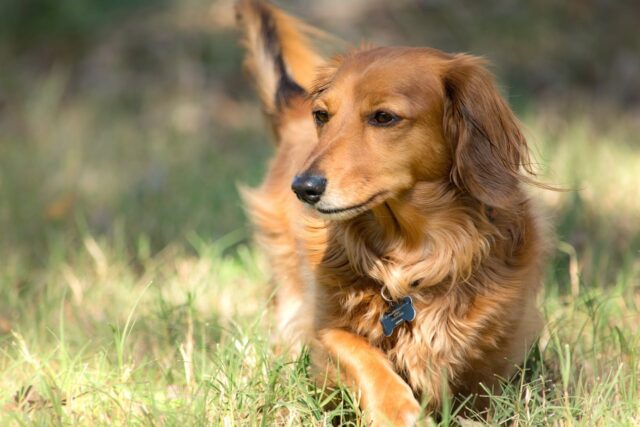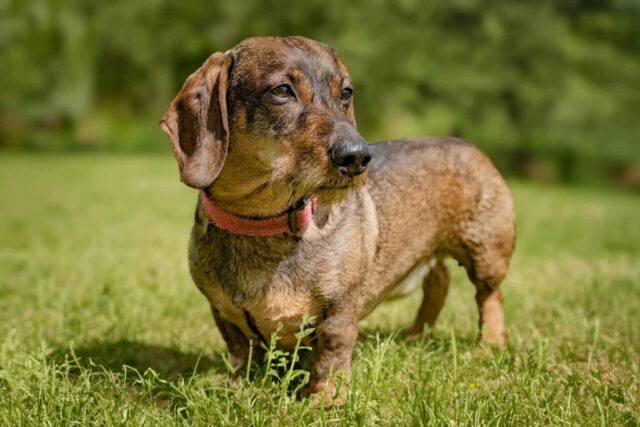Dachshunds, affectionately known as “wiener dogs” or “sausage dogs,” are renowned for their long bodies, short legs, and big personalities. These little dogs have a unique charm, often burrowing under blankets or enthusiastically sniffing out the most intriguing scents. Despite their small size, Dachshunds are energetic and love to play, often defying their tiny stature with big attitudes. But like all dogs, they eventually reach their senior years. Typically, a dachshund is considered to be in the senior stage, around 8 to 10 years old. However, given their relatively long lifespan, some may remain spry and youthful even as they age. Let’s dive into the different stages of a Dachshund’s life and discover how these delightful dogs gracefully (and sometimes hilariously) embrace their golden years.

1. The Puppy Phase: A Bundle of Curiosity and Mischief
They are an adorable mix of curiosity and mischief in the first year of a Dachshund’s life. These little pups are known for their playful nature and boundless energy. There’s never a dull moment, whether they’re getting into trouble by exploring every nook and cranny or simply learning how to navigate their long bodies and short legs. It’s a time filled with teething, which means anything within reach is fair game for a good chew. Puppyhood is also when they develop their unique personalities, often showing a strong-willed and independent streak that will keep their owners on their toes.
2. The Adolescent Years: The Teenage Rebel
Dachshunds enter their adolescent phase from about 1 to 2 years old, where they might test boundaries and exhibit some rebellious behaviors. This is the “teenager” stage, characterized by bursts of energy and a penchant for ignoring commands. Training is crucial during this time, as these clever dogs can be quite stubborn. Their love for digging and burrowing, a trait rooted in their hunting background, may also become more pronounced. Despite the challenges, this phase is also when their endearing and playful nature shines through, making them a joy to be around.
3. The Adult Years: Confident and Characterful
Between 2 and 7 years old, Dachshunds are in their adult prime. This stage is marked by a confident and characterful demeanor. They are fully grown, both in body and personality, and are often quite active and playful. Whether chasing after a ball or enjoying a sunny spot by the window, Dachshunds are known for their zest for life. They have also been highly social during these years, enjoying interactions with their family and other pets. This is when they are most likely to showcase their full range of vocal expressions, from joyful barks to more demanding whines, ensuring they are always the center of attention.
4. The Middle Ages: A Softer, Calmer Side
Around 7 to 10 years old, Dachshunds begin to show signs of slowing down. They might still enjoy a good play session but are generally more relaxed and less hyperactive than in their younger years. This period is often marked by a greater appreciation for naps and a love for cozy, warm spots—especially under a pile of blankets. They may become more affectionate, preferring to cuddle with their favorite humans. Their mischievous streak might mellow, but their loyalty and love for family remain unwavering. It’s a time when their quirks and charms become even more endearing.
5. The Senior Years: Wisdom and Waddles
When a Dachshund reaches 10 years old, they are considered seniors. This phase brings noticeable changes, such as graying fur around the muzzle and a slower gait. They may experience joint stiffness or arthritis, making them more cautious with their movements. Despite these changes, senior Dachshunds often retain a playful spirit and may prefer more leisurely activities. They continue to be curious and may enjoy exploring at a slower pace. Their affectionate nature often deepens, and they may seek more companionship and reassurance from their owners.
With their unique looks and lovable personalities, Dachshunds bring joy at every stage of their lives. From the playful puppy years to the wise senior stage, these little dogs are full of character and charm. While they may slow down as they age, their love and loyalty never wane. Cherishing every moment with your Dachshund, whether they’re bouncing around or enjoying a cozy nap, is key to appreciating the special bond you share. After all, Dachshunds have a way of capturing hearts with their distinct quirks and unwavering devotion, making every year with them truly special.
Frequently Asked Questions Someone Might Have About Their Aging Dachshund

1. How can I tell if my Dachshund is entering their senior years?
Dachshunds are typically considered seniors around 8 to 10, although some may begin to show signs of aging earlier or later. Common indicators include a decrease in energy levels and increased time spent resting. They may also exhibit stiffness or difficulty moving, particularly after resting, which could be signs of arthritis. Grey hairs, especially around the muzzle, and a duller coat are common as they age. Behavioral changes, such as being less interested in playing or taking longer to respond to commands, can also be signs of aging. It’s important to monitor these changes and consult your vet to ensure your Dachshund’s health is properly managed as they transition into their senior years.
2. What are common health issues in aging Dachshunds?
Aging Dachshunds are prone to several health issues. One of the most common problems is Intervertebral Disc Disease (IVDD), which affects the long spines and can lead to pain, mobility issues, or even paralysis. Arthritis is another frequent issue, causing joint pain and stiffness. Dental problems, including gum disease and tooth decay, are also common as they age. Dachshunds may develop heart disease, especially mitral valve disease, which can affect their cardiovascular health. Additionally, they are prone to obesity, which can exacerbate other health problems. Regular veterinary check-ups are essential for monitoring these conditions and providing appropriate care and treatment.
3. How should I adjust my Dachshund’s diet as they age?
As Dachshunds age, their metabolism slows down, and they may become less active, increasing the risk of weight gain. Adjusting their diet to maintain a healthy weight and support their overall health is important. Consider switching to a senior dog food formula, typically lower in calories but higher in essential nutrients like protein and fiber. These formulas often include supplements such as glucosamine and chondroitin for joint health and omega-3 fatty acids for anti-inflammatory benefits. Ensure your Dachshund is getting enough water, and consider feeding smaller, more frequent meals to aid digestion. Consult with your veterinarian to tailor the diet to your dog’s specific needs, especially if they have health issues like kidney disease or dental problems.
4. How much exercise does an aging Dachshund need?
While aging Dachshunds may not have the same energy levels as their younger years, regular exercise is still important for their physical and mental health. Aim for at least 20 to 30 minutes of moderate exercise daily, such as walking or gentle play. Exercise helps maintain a healthy weight, strengthens muscles, and supports joint health, which is particularly important for Dachshunds prone to back issues. Avoid high-impact activities that could strain their spine or joints, and be mindful of signs of fatigue or discomfort. Mental stimulation, such as puzzle toys or training exercises, keeps their minds sharp. Always consult your vet before starting a new exercise routine, especially if your dog has health concerns.
5. How can I help my Dachshund manage back problems?
Back problems, especially Intervertebral Disc Disease (IVDD), are common in Dachshunds due to their long spines. To help manage or prevent back problems, maintain a healthy weight for your dog to reduce stress on their spine. Avoid activities that involve jumping or strenuous movements, and provide supportive bedding to cushion their spine during rest. You can also consider using ramps or steps to help them navigate furniture or stairs. If your Dachshund shows signs of back pain, such as reluctance to move, crying out, or arching their back, seek veterinary care immediately. Treatments may include rest, medication, physical therapy, or in severe cases, surgery. Regular veterinary check-ups can help catch and manage these issues early.
6. Should I be concerned about my Dachshund’s dental health?
Dental health is crucial for aging Dachshunds, as they are prone to gum disease, tooth decay, and tooth loss. Regular dental care is important to prevent these problems. Brush your dog’s teeth regularly using dog-specific toothpaste and a soft brush. Dental chews and toys designed to clean teeth can also help reduce plaque buildup. Annual dental check-ups with your vet are essential for early monitoring and addressing any dental issues. If your Dachshund has dental problems, they may experience pain, difficulty eating, or even behavioral changes. Good dental hygiene can significantly improve their quality of life as they age.
7. How can I keep my aging Dachshund comfortable at home?
Consider making a few adjustments around the home to keep your aging Dachshund comfortable. Provide a supportive orthopedic bed to alleviate pressure on their joints and back. If your dog has difficulty navigating stairs or entering furniture, consider using ramps or pet steps. Keep their food and water bowls comfortable to reduce strain on their neck and back. Ensure they have a warm, draft-free space to rest, as older dogs can be more sensitive to cold temperatures. Regular grooming and nail trimming are important to keep them comfortable and mobile. Maintaining a calm and quiet environment can also help reduce anxiety and stress.
8. What should I do if my Dachshund is losing their hearing?
If your dachshund is losing its hearing, there are several ways to help it adjust. Use hand signals or visual cues for commands, as these can be more effective than verbal ones. It’s important to approach them from the front to avoid startling them. Create a consistent routine to help them feel secure and reduce anxiety. Consider using vibration or gentle tapping to get their attention. Keep them on a leash outside, as they may not hear dangers like approaching vehicles. Avoid loud noises that could startle them at home and provide a calm and safe environment. Consult your vet for further advice and possible treatments.
9. How do I manage my Dachshund’s weight as they age?
Managing your Dachshund’s weight is crucial as they age to prevent obesity and related health issues like joint problems and diabetes. Adjust their diet to include fewer calories, and opt for high-quality senior dog food with balanced nutrients. Measure their food portions accurately and avoid overfeeding or excessive treats. Incorporate regular, moderate exercise into their routine to help maintain a healthy weight and muscle mass. Activities like walking or gentle play are ideal, but always be mindful of their physical limitations. Regular weigh-ins and veterinary check-ups can help monitor their weight and overall health. Addressing weight management early can prevent more serious health complications down the road.
10. How can I mentally stimulate my aging Dachshund?
Mental stimulation is important for aging Dachshunds to keep their minds sharp and prevent cognitive decline. Interactive toys, like puzzle feeders, can challenge them and provide mental engagement. Training sessions can be stimulating and rewarding, even just practicing basic commands. Scent games, such as hiding treats for them to find, are also enjoyable and mentally stimulating. Socializing with other dogs or new people can provide new experiences and mental engagement. Regularly rotating their toys can also keep them interested and prevent boredom. Keep the activities short and positive, and always tailor them to your dog’s abilities and energy levels.
 Toledo, United States.
Toledo, United States.